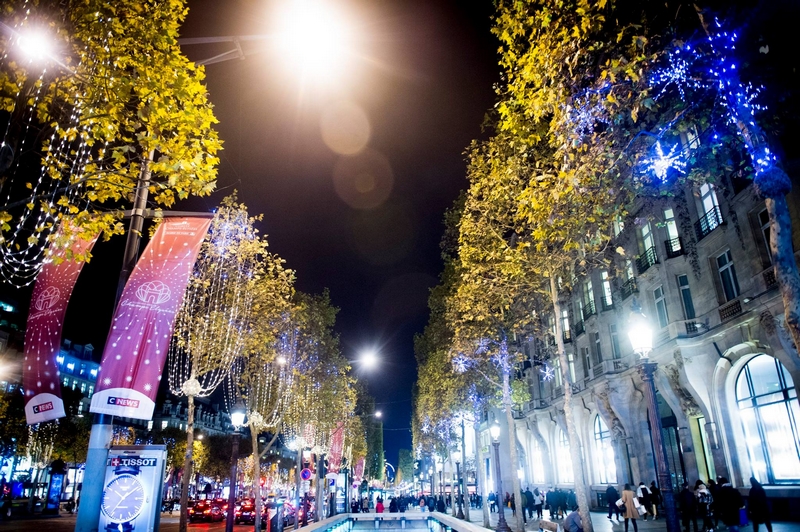The Champs-Élysées, often called the “most beautiful avenue in the world”, is not what it was. The pavements are cracked, the trees that line the cobbled, traffic-clogged road struggle to survive in one of Paris’s most polluted areas, and Parisians stay away.
Now local community leaders have unveiled an ambitious €250m (£212m) project to restore the celebrated 1.2 mile (1.9km) long avenue to at least some of its former glory.
“It’s often called the world’s most beautiful avenue, but those of us who work here every day are not at all sure about that. The Champs-Élysées has more and more visitors and big name businesses battle to be on it, but to French people it’s looking worn out,” Jean-Noël Reinhardt, president of the Champs-Élysées committee said.
Reinhardt says his association, which represents those who live, work and trade on the avenue running from the Arc de Triomphe on Place Charles de Gaulle to Place de la Concorde, will present their plans to the candidates standing in next year’s municipal elections in January.
The Champs-Élysées makeover would need public and private investment, he told journalists.
“The last renovation of the Champs-Élysées was 25 years ago. We must bring the Champs-Élysées into the 21st century,” Reinhardt said. “We need to modernise, de-stress [the avenue] and encourage Parisians to come back”.

The Champs-Élysées was originally a mixture of swamp and kitchen gardens when André Le Nôtre, gardener to Louis XIV the Sun King, first laid out the wide promenade lined with a double row of elm trees on each side, called the Grand Cours. In 1709, it was renamed the Champs-Élysées and extended, and by the end of the century had become a popular place to walk and picnic.
The city celebrated its liberation from the Nazis in 1944 on the Champs-Élysées and World Cup victories still bring out the crowds, but its famous charm has faded. Today it is known for its expensive cafes, luxury shops, high-end car salesrooms and commercial rents that are among the highest in the world, as well as the annual Bastille Day military parade. More recently it was the scene of some of the most violent clashes between gilets jaunes and riot police.
Its name is French for the mythical Greek paradise, the Elysian Fields; but Parisians largely shun it.

Architect Philippe Chiambaretta, whose firm PCA-Stream drew up the plans, said research showed that of the estimated 100,000 pedestrians on the avenue every day, 72% are tourists and 22% work there. The eight-lane highway is used by an average of 3,000 vehicles an hour – most passing through – and is more polluted than the busy périphérique ring road around the French capital.
Chiambaretta said it needed to be developed to be “ecological, desirable and inclusive”.
“It was always designed for the people and shouldn’t just be a luxury avenue,” Chiambaretta said.
He admitted the Champs-Élysées had become a place that summed up the problems faced by cities around the world: “Pollution, the place of the car, tourism and consumerism.”
The ambitious plans include reducing the space for vehicles by half, creating tunnels of trees and encouraging more aesthetic use of commercial spaces such as terraces. The committee also wants a major rethink of the area all around the Champs-Élysées to make it more pedestrian friendly up to and including the nearby River Seine, with traffic diverted into a tunnel.
“We work here every day so we know we have to profoundly change things. We can’t just say it’s the responsibility of the public authorities. We want the Champs-Élysées to remain a centre of attraction in the world, we want tourists to keep coming but we want the Parisians who used to come here 100 years ago to come back,” Reinhardt said.

Plans to improve the Champs-Élysées are not new, but as Paris prepares to host the 2024 Olympics, there is an impetus to spruce up the city’s most celebrated street before the world descends.
A Paris city hall spokeswoman said the Champs-Élysées is already closed to traffic one Sunday every month and the city authorities had already carried out work including a cycle lane on the avenue.
Chiambaretta says some of the work could begin after next year’s elections, but the wider project would have to wait until after the games.
Futuristic sketches showing the Arc de Triomphe surrounded by sand and water or transformed into an ice rink are, Chiambaretta admits, probably a pipe dream.
Giving the Champs Élysées and its surroundings a makeover is not, he says. “We have to think big and not just about the Champs-Élysées, but all around it,” he says.
The proposals are in the early stages and would need the approval of the Paris authorities and public investment. City Hall did not wish to comment on the plans drawn up by the committee.
guardian.co.uk © Guardian News & Media Limited 2010
Published via the Guardian News Feed plugin for WordPress.


